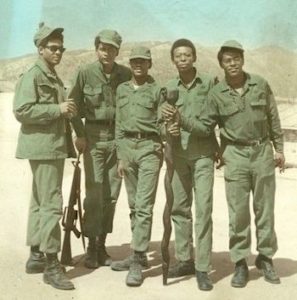
*On this date in 1967, Black history in the Vietnam War is briefly written about. The Vietnam War was the first American war in which Black and white troops were not formally segregated, though de facto segregation still occurred. American troops arrived in 1961.
Blacks were more likely to be drafted than whites. Though 11% of the US population in 1967, African Americans comprised 16.3% of all draftees. Most African Americans drafted were not conscripted, with 70% of black draftees rejected from the Army. Project 100,000, which helped dramatically increase US troop presence in Vietnam from 23,300 in 1965 to 465,600 two years later, sharply increased the number of Blacks drafted. By lowering the education standards of the draft, an estimated 40% of the 246,000 draftees of Project 100,000 were Black. Some activists in the US speculated that the uneven application of the draft was a method of Black genocide.
Blacks were starkly under-represented on draft boards in this era, with none on the draft boards of Louisiana, Mississippi, Alabama, or Arkansas. In Louisiana, Jack Helms, a Grand Wizard of the Ku Klux Klan, served on the draft board from 1957 until 1966. In 1966, 1.3% of the members of the US draft board were Black. By 1970, the number grew from 230 to 1,265, representing only 6.6% of all draft board members. Across all military branches, African Americans comprised 11% of all troops. However, a disproportionate number were made officers, with only 5% of Army officers African American and 2% across all branches. Black troops were more likely to be assigned to combat units: 23% of such forces in Vietnam were Black. Racism against Blacks was particularly pronounced in the Navy. Only 5% of sailors were Black in 1971, with less than 1% of Navy officers African American.
Racism was typical in American bases in Vietnam. After the Assassination of Martin Luther King Jr., some white troops at Cam Ranh Base wore Ku Klux Klan robes and paraded around the base, continuing their celebration by cross burning. Da Nang Air Base flew the Confederate flag for three days in response. In addition to being used in response to King's murder, Confederate flags and icons were commonly painted on jeeps, tanks, and helicopters; bathroom graffiti proclaimed that African Americans, not the Vietnamese, were the real enemy. Black troops were discouraged from taking pride in Black identity, with one troop ordered to remove a "Black is beautiful" poster from his locker. Black identity publications and speeches were restricted, with some commanders banning recordings of speeches by Malcolm X or the newspaper The Black Panther.
Black culture and norms were also not initially acknowledged in on-base locations. Black troops could not access black hair care products, music tapes, books, or magazines about Black culture and history. Instead, the Armed Forces Radio Network mostly played country music. Military barbers often lacked experience cutting Black hair and received no formal training on how to do so. The Armed Forces took some action to make Black troops feel more included, including adding more diverse music to club jukeboxes, hiring Black bands and dancers for events, and bringing over black entertainers to perform, such as James Brown. In 1970, Miss Black America '17 and '72 toured, and Miss Black Utah paid a visit. Base exchanges began to stock Black haircare products and garments, such as dashikis, while books about Black culture and history were added to the base libraries. By 1973, military barbers had been trained how to cut Black hair. Ultimately, many of these changes were made towards the end of the war when personnel had been significantly reduced, meaning that most Black troops who served during the Vietnam War did not benefit from these reforms.
Racial tensions created internal divisions, causing Black soldiers to sometimes refuse to fight. One such incident near the A Sầu Valley caused fifteen Black soldiers to refuse to report for combat patrol the following day. Almost 200 black troops imprisoned at Long Bình Jail staged a work strike for over a month following a riot. In another incident, a race riot occurred on the USS Kitty Hawk after the ship was forced to cancel its trip home and return to Vietnam. Black and White sailors attacked each other with chains and pipes, arresting twenty-five Black sailors and no white ones. On the USS Constellation, Black sailors organized to investigate the application of non-judicial punishment among white and Black sailors. Six organizers were given less-than-honorable discharges, with rumors that up to 200 Black sailors would receive the same sentence.
On November 3, 1972, about 100 Black sailors and a few white sailors staged a racial sit-in protest on the ship's deck. Many dissidents were ultimately reassigned from the boat, with a few discharged. Several Black troops deserted their posts. A few were smuggled through the USSR into Sweden, while up to 100 lived in a region of Saigon known as Soul Alley. It has been investigated whether or not Black troops were less likely to be nominated for a Medal of Honor than White troops; out of 3,500 recipients, only 92 have been Black men.
As of 2019, John L. Canley was the most recent recipient of the Black Medal of Honor from the Vietnam War. Twenty-two Black men have received the Medal of Honor for actions undertaken during the Vietnam War. This date was selected because on June 20, 1967, a Houston jury convicted Muhammad Ali of a felony charge of violating the Universal Military Training and Service Act by refusing to be drafted to fight in Vietnam.